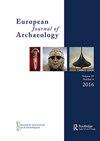Mounds Against the State? An Anarchist Approach to Mound Construction, Environmental Stress, and Centralization of Power in Viking and Merovingian Age Scandinavia
IF 1.2
2区 历史学
0 ARCHAEOLOGY
引用次数: 0
Abstract
In this article, the author explores the cooperative aspects of mound construction in Late Iron Age Scandinavia. Arguing against the outdated but widely held view that only centralized rule could organize monument construction, he investigates how participation in mound construction affected the people of Sør-Fron in south-eastern Norway. He contends, first, that repeated participation in mound construction helped create a sense of belonging and shared identity, which was maintained through centuries of major environmental and political turmoil. Second, mound construction was part of an active and conscious strategy to limit aggrandizement and prevent centralization and concentration of power. Rejection of Christianity arguably worked in similar ways. The author concludes with considerations of approaches to Iron Age monuments, emphasizing the importance of consensus and community-building and the role of communal opposition to centralized rule.土丘反对国家?从无政府主义角度探讨维京和墨洛温时代斯堪的纳维亚的土丘建造、环境压力和权力集中问题
在这篇文章中,作者探讨了铁器时代晚期斯堪的纳维亚地区土丘建造的合作方面。他反对只有中央统治才能组织纪念碑建造这一过时但却广为流传的观点,研究了参与土丘建造对挪威东南部索-弗隆(Sør-Fron)人的影响。他认为,首先,反复参与土墩建造有助于形成一种归属感和共同的身份认同,这种归属感和共同的身份认同在经历了几个世纪的重大环境和政治动荡后得以保持。其次,建造土丘是一种积极和有意识的策略的一部分,目的是限制扩张,防止中央集权和权力集中。可以说,拒绝基督教也有类似的作用。最后,作者对研究铁器时代古迹的方法进行了思考,强调了共识和社区建设的重要性,以及社区反对中央集权统治的作用。
本文章由计算机程序翻译,如有差异,请以英文原文为准。
求助全文
约1分钟内获得全文
求助全文
来源期刊

European Journal of Archaeology
ARCHAEOLOGY-
CiteScore
3.40
自引率
6.70%
发文量
58
期刊介绍:
The publication organ of the European Association of Archaeologists, the European Journal of Archaeology seeks to promote open debate amongst archaeologists committed to a new idea of Europe in which there is more communication across national frontiers and more interest in interpretation. The journal accepts not only new empirical data and new interpretations of the past but also encourages debate about the role archaeology plays in society, how it should be organized in a changing Europe, and the ethics of archaeological practice. All periods are covered; papers, review articles, interviews and short "debate" pieces are all sought. Whilst English is the primary language of publication in the EJA, papers submitted in French or German will be given equal consideration.
 求助内容:
求助内容: 应助结果提醒方式:
应助结果提醒方式:


